ExhibitionsRecent Acquisitions from the Aileen M. Smith Collection
W. Eugene Smith: Photography
Recent Acquisitions from the Aileen M. Smith Collection
W. Eugene Smith: Photography
HOME > Exhibitions > Recent Acquisitions from the Aileen M. Smith Collection W. Eugene Smith: Photography
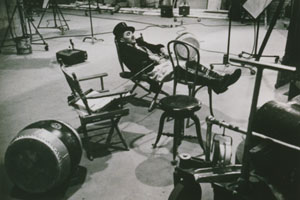
W. Eugene Smith (1952) Chaplin
The National Museum of Modern Art, Kyoto
American photographer William Eugene Smith (1918–1978) passed away in Tucson, Arizona on October 15, 1978, leaving an indelible mark on the history of photojournalism through his outstanding photographic essays published in the pictorial magazine Life, such as Spanish Village (1950/51), and his photographic report on mercury pollution in Minamata of world-wide renown. He was fifty-nine years old.
Over the course of the past fifteen years, the National Museum of Modern Art, Kyoto has successively made acquisitions of Eugene Smith’s works. These works have been acquired from the selective personal collection of Aileen Mioko Smith, former wife and partner in recording and reporting the industrial pollution and its consequences in Minamata, a city in Kumamoto prefecture. Composed of 284 prints in all, this collection covers nearly the entire scope of Smith’s career, with works from series such as World War II (1943–45), photographed for Life magazine as a war correspondent; Country Doctor (1948), a monument in the field of photographic essays; Nurse Midwife (1951), presenting a rather unlikely hero in midcentury America; A Man of Mercy (1954), featuring Renaissance man Dr. Albert Schweitzer; Pittsburgh (1955–56), an ambitious series that he took far beyond his original assignment; and Minamata (1971–75), his final serial work that cemented his connection with Japan. The vast majority of the prints were made by Smith himself according to his famously exacting standards. All 284 prints are scheduled to be acquired as the “Aileen M. Smith Collection” in the collection of the National Museum of Modern Art, Kyoto.
Eugene Smith was born in Wichita, Kansas. In 1937, having turned eighteen, he moved to New York in pursuit of his dream of becoming a professional photographer. At the time, weekly news magazines with emphasis on photography such as Newsweek (founded 1933) and Life (founded 1936) were enjoying a sharp increase in circulation. A new style of reportage known as pictorial magazines and photojournalism had emerged and were advancing on the road to prosperity. Eugene Smith’s on-site work during World War II established him as a star photographer at Life, and he continued to support the magazine’s golden age until 1954. His photographic essay Minamata was published in the June 2, 1972 issue, making his final contribution of brilliance before the magazine suspended its publication with its December 29, 1972 issue.
In this way, the history and accomplishments of the photographer have been evaluated and verified in the context of the history of photojournalism. This, however, has the effect of forcing him into the framework of ‘press photography.’
Eugene Smith came face to face with the devastating reality of land war in Saipan, Iwo Jima, and Okinawa. There, he began to contemplate the fortuity of the relationship of the photographer and his subjects: That could have been me on the other side of the camera. In other words, he abandoned the position of the neutral photographer and chose instead to identify with his subjects. After World War II, Eugene Smith spent almost an excessive amount of time and effort doing scrupulous research in order to gain a deeper understanding of his subjects, and created many striking works that closed in on the subjects’ essence, or sometimes even seemed to pursue a universal quality further beyond. What he aspired toward was photography that represented the ‘truth’ rather than mere visual reality—that is to say, iconic photography that makes a clear symbolic presentation of the ‘truth’ that lies behind the usual report of reality found in press photography. In order to create this ‘symbolic image,’ he skillfully implemented the composition and contrast of classic painting, and made full use of darkroom techniques such as superimposition and trimming. In the midst of the world of press photography, the dogma of which is documentation and objectivity, Eugene Smith upheld a position toward creation and a methodology that were based on subjectivity. The criticism that continues to match the high appraisal of his work to this day in the world of ‘press photography’ may be inevitable, given this entirely subjective approach to creation that he maintained. This collection of works by Eugene Smith—who pursued a symbolic expression that went beyond documentation, to become an artist who went beyond the photographer in the traditional sense, even within the framework of press photography into which he was forced by others—represents his self-contradictory challenges and inner struggle.
As of 2008, the accession of the Aileen M. Smith Collection has only just passed the midpoint of the process. We have decided, however, that it would be appropriate to present the works to the public in commemoration of the thirtieth anniversary of the photographer’s death, to reflect on and to reconsider the ideals that he commended to photography as well as the expressive aspect of the medium. 170 works have been selected from the collection to represent the entire scope of W. Eugene Smith’s career.
Related Events
Commemorative lecture: “Eugene Smith and Me”
Date: August 9 (Sat.) 2:00PM–3:30PM
(numbered tickets distributed 11:00AM–)
Lecturer: Aileen Mioko Smith
Place: Lecture hall (maximum capacity 100); free
in Japanese only
- Exhibition dates
- Tuesday, August 5 – Sunday, September 7, 2008
- Closed on Mondays
- Hours
- Regular hours
- 9:30AM–5:00PM (admission until 4:30PM)
- Evening hours (every Friday until September 5 + Saturday, August 16)
- 9:30AM–8:00PM (admission until 7:30PM)
- Organizer
- The National Museum of Modern Art, Kyoto
- Admission
| Day of admission | Group (20 or more) | |
|---|---|---|
| Adult | 420 | 210 |
| University students | 130 | 70 |
| High school and younger | Free | Free |
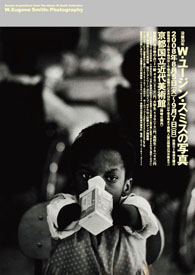
- Flyer design proposal
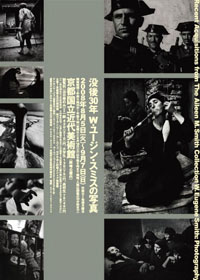
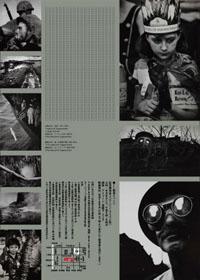
- Ticket design proposal

- Flyer (PDF 715KB)
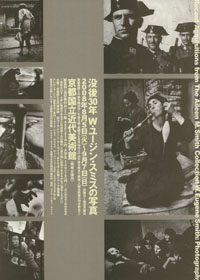
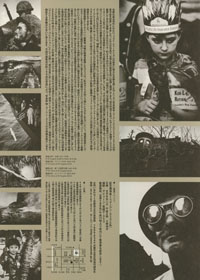
Top of this page




